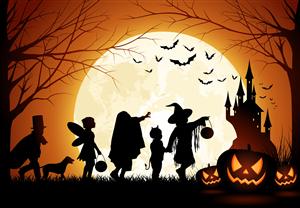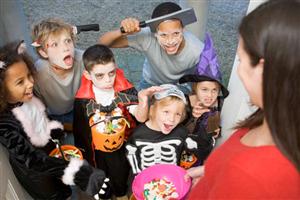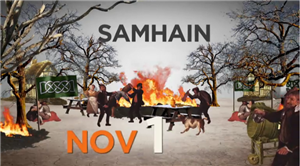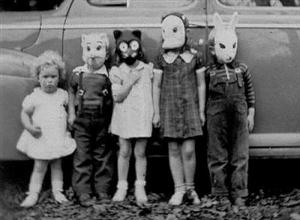
Halloween is one of the most iconic and evolved of American holidays. On Halloween (the 31st of October) in current times the most common traditions include dressing up in costume as frightening beings, famous characters, ironic jokes, symbolic professions- basically any sort of costume that transforms from the everyday person. Themes of darkness, death, and legendary creatures of the night are symbolic to this holiday. Houses are often decorated with spider webs, bats, grave stones, and other terrifying themes. Jack-O-Laterns (pumpkins carved with faces or scenes illuminated from the inside by candles) can be seen on doorsteps of most houses. Candies and treats are eaten more than any other American holiday of the year on this day.

This is mostly because children traditionally go door to door of the houses in their neighborhoods in such costumes on this night. The classic greeting when the door is opened is for the children to say “trick or treat?” and the response to give children candy- a “treat”. Parties are often held on this night as well by children and adults alike. Similar dark-themed decorations are seen at these parties with the colors of black and orange most common with most attendees expected to be in costume. Games are often played at these parties such as “bobbing for apples” where apples are placed into a large pail of water and contestants must catch hold of an apple using only their mouth. To someone who has never celebrated such a holiday this may seem like a menagerie of some of the oddest traditions. What is the meaning of Halloween and where did these seemingly strange traditions come from? Let’s find out!

Halloween actually has its origins in Irish tradition. Evolving from the ancient Celtic holiday of Samhain, modern Halloween has become less about literal ghosts and ghouls and more about costumes and candy. Starting around 2,000 years ago, the Celts used the day to mark the end of the harvest season and the beginning of winter, and also believed that this transition between the seasons was a bridge to the world of the dead. The night before the holiday of Samhain (October 31st) the Celts believed the dead came back to the world of the living. They would leave food and wine out on the doorstep in offering to the dead to keep the spirits at bay and wear masks when leaving the house in order to be mistaken as other ghosts or spirits. In the 8th century the Catholic church converted the name of the holiday into “All Saints Day” or “All Hallows Day” therefore, the night before became “All Hallow’s Eve” and later was shortened to Halloween. During this time is was common for the destitute youth of Britain to go door to door in their costumes asking for donations of food, money, or drink in exchange for prayers for the dead or jokes and entertainment. The Irish and Scottish immigrant to the United States brought this tradition over in a revised form. If the home-owners did not give these costumed youths a “treat” or donation, they often played pranks such as throwing eggs at the home or playing jokes as a “trick” and thus began “trick-or-treating”.

In the 1950’s with the huge surge in youth population in the United States the holiday became a much more friendly youth-oriented holiday much more similar to the Halloween today. Over the millennia the holiday has transitioned from a somber pagan ritual to a day of merriment, costumes, parades and sweet treats for children and adults. Want more information the evolution of Halloween? Check out this neat History.com video about the holiday!
Do you celebrate Halloween? If so, how? Does your home country have a similar seasonal holiday? What’s your favorite part about Halloween? We want to know!
